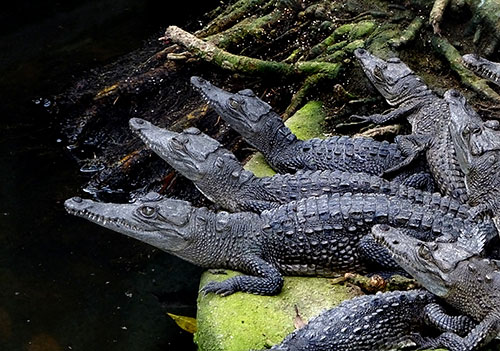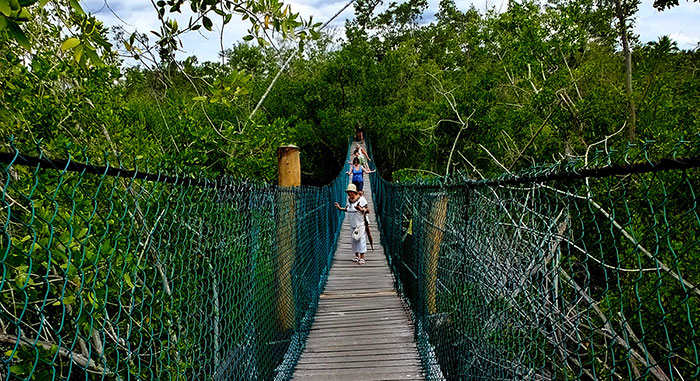|
By John Pint
 “Mexico’s
biggest crocodile sanctuary is only 20 minutes from here,” I told my
sister-in-law while relaxing on a balcony overlooking the beautiful bay
of Cuastecomates, near Barra de Navidad. She opened one eye and gave me
a glance that seemed to say, “A cocodrilario?
Ah, yes, toothy monsters
that never move a muscle, piled topsy-turvy behind a cyclone fence:
boooooring!” “Mexico’s
biggest crocodile sanctuary is only 20 minutes from here,” I told my
sister-in-law while relaxing on a balcony overlooking the beautiful bay
of Cuastecomates, near Barra de Navidad. She opened one eye and gave me
a glance that seemed to say, “A cocodrilario?
Ah, yes, toothy monsters
that never move a muscle, piled topsy-turvy behind a cyclone fence:
boooooring!”
Fortunately, her sister Susy came to my rescue:
“Not boring at all, Bety! The local people love crocodiles and feed
them like we feed squirrels. Even the little kids participate. You
should see the expressions on their faces when they’re carefully
carrying newly laid eggs to a place where they can safely hatch.”
Well,
the human dimension of the Cocodrilario caught Bety’s attention and off
we went, the three of us, to tiny La Manzanilla, located 56 kilometers
northwest of the bustling port of Manzanillo, with which it should not
be confused.
The crocodile sanctuary used to be rather
inconspicuous, with nothing more than a little sign warning visitors
not to bring their dogs any closer. Crocs, they had told us, have been
feuding with dogs since time immemorial and are ever so happy to gobble
one up... and there is a great legend about How the Crocodile Lost its Tongue.
Today,
however, we found big signs pointing to the newly revamped entrance and
informing us that the estuary of La Manzanilla was declared an official
Ramsar Wetland in 2008. The local people had been fighting for years to
protect their mangroves from “developers” who had been systematically
converting the marshland into real estate, continually reducing the
space supporting not only crocodiles, but a wide variety of birds,
fish, mollusks, crustaceans and reptiles.
We paid the 25-peso
entrance fee and found ourselves on a narrow boardwalk suspended above
the estuary waters. “This is new,” we told Bety. “Apparently Ramsar
status has resulted in funding.” The boardwalk brought us within a few
meters of crocodiles of all sizes, some with names like “Pancho” who,
we learned is 46 years old, weighs 380 kilos and is four meters long. All
of these creatures are
Crocodylus
acutus, American Crocodile in English and Cocodrilo
Amarillo
in Spanish. They seem to be fresh-water river crocodiles with a great
tolerance for salt water and live to reach an age of 80 years, although
we were told that one inhabitant of El Cocodrilario is 100 years old.
They are said to be less aggressive than other kinds of crocodiles.

Hanging bridge adds excitement to
the 650-meter walk through the estuary.
Visitors
are allowed to feed the crocs here, many of which looked quite lively
as they raced to gulp down a treat with a toothy grin.
We
had not taken more than twenty steps along the boardwalk when we found
ourselves face to
face with a yellow-crowned night heron perched on the walkway railing.
We were amazed, as it was 1:00 in the afternoon, the very worst time
imaginable for bird-watching.
I had supposed that the boardwalk
would follow the rather short trail that had been here during my last
visit. Instead, it now takes you on a 650-meter circular route through
the mangroves as well as through open waters, allowing you to quietly
approach the natural inhabitants of the estuary. So we got to see, up
close, not only crocs and iguanas, but a wide variety of water birds,
including anhingas, tropical kingbirds and a white ibis..
Halfway around the route, there’s a lookout tower
offering a great view of the estuary and at the end of the loop you
come to a crocodile nursery, where, of course, you can take a picture
of yourself with a baby croc in your arms. Here we learned that the
sanctuary, which covers some 264 hectares, has a population of 400 to 500 American Crocodiles at the moment and is
continuously making improvements, like recently installed toilets.
“Several biologists are now working with us,” we were told, “and very
soon we will be opening our own crocodile museum.”
“People
here in La Manzanilla are used to living with crocodiles,” explained
Gabriela Martínez, a volunteer at the Cocodrilario. “Over the years, we
got used to feeding the crocs just like Norteamericanos might feed
pigeons,” she said, and eventually just about every crocodile in the
area ended up leading the good life in the little estuary or lagoon
that has now become El Cocodrilario. “Many years ago (at least 20) we
formed an organization called Cipactli, which means crocodile in
Nahuatl and after a number of years we were declared an Unidad de
Manejo Ambiental or UMA (Environmental Management Unit) by
the
government. While this designation denotes official approval of an
animal-related project, it does not necessarily imply any financial
assistance."

View of estuary from watchtower.
At this moment, we were
distracted by loud shouting
coming from one of several fenced-in enclosures. While the great
majority of the crocs at the Cocodrilario are completely free to come
or go, a few “trouble-makers” have been brought in from other areas and
are kept locked up. We went to check out the commotion and found out an
Egg Rescue was in operation. “A female has just laid several eggs and
the others are trying to eat them,” we were told.
The rescue
required two people to “distract” the cannibalistic crocs while another
fished out the eggs with a net at the end of very long pole. A group of
wide-eyed children then carefully carried the eggs to a protected,
sandy area where they were buried by other volunteers. “These eggs will
hatch in about 90 days,” we were told by Francisco Perez Mendoza, one
of the original founders of Cipactli.
Curious
as to why the local people had gone to so much trouble to protect and
feed crocodiles, we approached an old-timer minding a table covered
with knickknacks.
“It’s not just the crocodiles we’re trying to
protect,” commented Don José Garcia. “You see, some years ago we
noticed a dramatic increase in wild birds and animals like possums,
pumas, raccoons and badgers in this lagoon and we wondered why this was
happening, why so many usually reclusive animals were now coming here.”
This was how Garcia
and others discovered that land development projects were uprooting the
local mangroves and reclaiming the swamp land. “Millionaires were
buying up the land and destroying the natural habitats of these birds
and animals and the more we looked, the more construction projects of
this sort we discovered. We came to the conclusion that this estuary of
ours may end up being the last refuge for all kinds of creatures that
no longer have any place to go. So we are determined that our
Cocodrilario must remain one place that will never be ‘developed.’
That’s why the only form of tourism we allow here is boat rides up the
estuary.” Activist
and eco-preneur Davison Collins, who worked on the first crocodile
inventories and studies in the estuary, says the cocodrilario, the
pending "Crocodile Museum" and the interpretive mangrove birding tours
in La Manzanilla are “prime examples of well-integrated community based
eco-tourism and conservation initiative which help insure that the
community of La Manzanilla will continue to control and cherish its
most valuable jewel—its mega-diverse mangrove—and not fall prey to yet
another tragedy of the commons scenario. Such a scenario occurred in
Barra de Navidad, for example, where their mangrove was significantly
compromised to the point that the once-thriving shell fish population
plummeted and now they´re having major erosion problems with their
beach, among other environmental problems directly related to the
destruction of their mangrove."
Costalegre Eco-Adventure (Tel
315 351-5305) offers a dusk boat ride (1.5 hours) through the estuary
and has a beautifully illustrated guide to 63 resident species of birds
and 16 migratory. The guide lists all these birds in English, Spanish
and Latin and you can get an electronic version of it from
costalegreecoadventure @ gmail.com (remove the spaces).
Visitors who want to do the evening boat ride could stay at one of the
local hotels, several of which have five-star ratings on Tripadvisor.
In addition, there are some nice campsites on the beach just north of
town.
The
sanctuary is open daily from 9 AM to 6:30 PM and is on Facebook as
“Cocodrilario Ejido La Manzanilla.” Should you visit it? Take Bety
Ibarra’s final word on the place: “The Crocodile Sanctuary turned out
to be the best part of my entire trip to the beach.”
How
to get there
The
fastest and most convenient route from Guadalajara is by toll road, via
Colima and Manzanillo. La Manzanilla is just a half-hour’s drive
northwest of Barra de Navidad/Melaque and is sign-posted. Drive into
the pueblito on Avenida Lázaro Cárdenas and, just before the road ends
at the beach, you´ll see the Cocodrilario on your right. Google Maps
lists it as Cocodrilario La Manzanilla, Jalisco. Driving time from
Guadalajara is about four and a half hours.

|

